|
427
Limited Edition
February 14, 2008
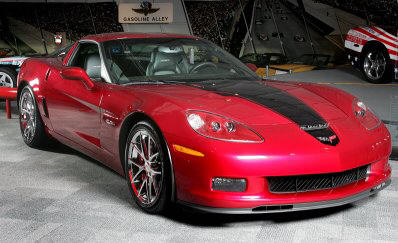 DETROIT
– Chevrolet announced the 2008 Corvette 427 Limited Edition
Z06, a limited-production model that pays homage to the big-block
Stingray models of the mid-1960s. The 427 designation refers to the
cubic-inch displacement for the highest-performance engines offered
between 1966 and ’69 – and is also the cubic-inch equivalent of the
Z06’s 7.0L LS7 small-block V-8. DETROIT
– Chevrolet announced the 2008 Corvette 427 Limited Edition
Z06, a limited-production model that pays homage to the big-block
Stingray models of the mid-1960s. The 427 designation refers to the
cubic-inch displacement for the highest-performance engines offered
between 1966 and ’69 – and is also the cubic-inch equivalent of the
Z06’s 7.0L LS7 small-block V-8.
The 427 Limited Edition
Z06 features a Crystal Red Tintcoat exterior, the first Z06 ever
offered with a red metallic tintcoat paint. It also features
graphics on the hood and fascia that evoke the style of the famed
“stinger” hood design and graphics that were offered with 1967
models equipped with the 427 engine. Also unique to this model are
“427” hood badges. Each example is numbered and signed by Wil
Cooksey, the Corvette assembly plant manager who is retiring after
15 years on the job, and comes with a certificate of authenticity.
“The heritage of the 427
designation with the Corvette is legendary,” said Harlan Charles,
Corvette product manager. “Recognizing the tie-in of the original
427 engine and the LS7’s 427-inch displacement has been on the
Corvette team’s mind since the Z06 was introduced, and we’re
thrilled to express it in this special model.”
Available under order
code Z44, this special Z06 enters production this spring. Only 427
will be offered in the United States and Canada, with 78 more
exported outside North America. That’s a total of 505 production
vehicles – the same number of horsepower produced by the LS7 engine.
The special-edition
Corvette carries a MSRP of $84,195 and includes the 3LZ premium
equipment package with a custom, leather-wrapped interior. A
navigation system is the only option ($1,750). As with other
Corvette models, customer delivery is available at the Corvette
Museum, in Bowling Green, Ky.
A
breakdown of the 427 Limited Edition Z06’s unique content includes:
- Crystal Red
Tintcoat exterior paint with stinger-style graphics and 427 hood
badges
- Exclusive, new
chrome wheels
- Body-color rear
spoiler and door handles
- Exclusive dark
titanium custom leather-wrapped interior
- Special Crystal
Red interior trim plate graphic pattern
- Console armrest
signed and numbered by Wil Cooksey
- “427”-embroidered
seats and floor mats
- “Z06” sill plates
The 427 Limited Edition
Z06 joins the Indy 500 Pace Car replica – available in coupe and
convertible configurations – as the second limited-production
Corvette model introduced for 2008, giving enthusiasts and
collectors a wealth of choices. In January, Chevrolet also announced
the 2009 Corvette ZR1, which enters production later this summer.
“There’s never been a
better time to be a Corvette enthusiast,” said Charles. “The
performance and refinement are exemplary and special editions, like
the 427 model, enrich the heritage of America’s sports car.”
Corvette Z06
details
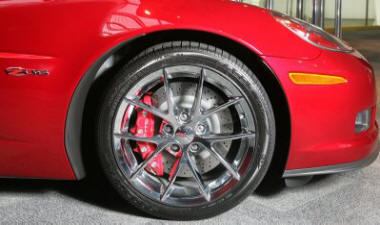
The Corvette Z06 that is
the foundation for the 427 Limited Edition offers carefully executed
levels of capability and technology, making it one of the best
performance values on the market.
The Z06’s LS7 7.0L engine
reintroduced the 427-cubic-inch engine to the Corvette lineup. It
uses racing-derived lightweight technology, including titanium
connecting rods and intake valves, to help boost horsepower and rpm
capability – it is rated at 505 horsepower (377 kW).* The only
transmission offered with the Z06 is a six-speed manual.
In the car’s 3,162-pound
(1,437 kg) package, the LS7 engine helps deliver 0-60 mph
performance of 3.7 seconds in first gear, quarter-mile times of 11.7
seconds at 125 mph and a top speed of 198 mph (as recorded on
Germany’s Autobahn) – the Z06 also circuited Germany’s famed N ü
rburgring racetrack in a time of 7:43.
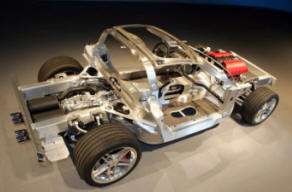 The Z06 has a unique
aluminum body structure for optimum stiffness and light weight for
the fixed-roof body style. Perimeter rails are one-piece hydroformed
aluminum members featuring cast suspension nodes, which replace many
welded steel components on other Corvette models. Advanced
structural composites featuring carbon fiber are bonded to the
aluminum structure. Wider front wheelhouses, for example, are carbon
composites and the passenger compartment floors combine carbon-fiber
skins with an ultra-lightweight balsa wood core. The Z06 has a unique
aluminum body structure for optimum stiffness and light weight for
the fixed-roof body style. Perimeter rails are one-piece hydroformed
aluminum members featuring cast suspension nodes, which replace many
welded steel components on other Corvette models. Advanced
structural composites featuring carbon fiber are bonded to the
aluminum structure. Wider front wheelhouses, for example, are carbon
composites and the passenger compartment floors combine carbon-fiber
skins with an ultra-lightweight balsa wood core.
A firm, race-proven
suspension works harmoniously with large 18 x 9.5-inch cast-spun
aluminum wheels and 275/35ZR18 tires in the front, and 19 x 12-inch
cast-spun aluminum wheels with 325/30ZR19 tires in the rear to
achieve lateral acceleration of more than 1 g. Complementing the
suspension system and large rolling stock is an equally capable
four-wheel disc brake system, consisting of 14-inch (355 mm) vented
and cross-drilled front rotors and 13.4-inch (340 mm) vented and
cross-drilled rear rotors.
The front rotors are
acted upon by large, red-painted six-piston calipers that use six
individual brake pads. Individual brake pads are used because they
deliver more equalized wear compared to what would otherwise be a
pair of very long single-piece pads. For the rear brakes,
four-piston calipers with four individual brake pads are used. A
Delphi four-channel ABS system is standard, as is a very competent
active handling system – complete with a Competitive Driving mode.
History of the Corvette and the 427 engine
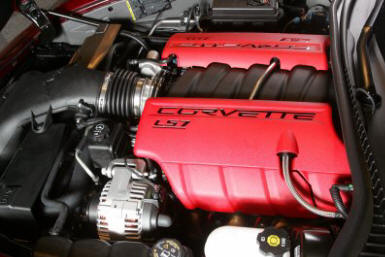 The
Chevrolet Mark IV V-8 debuted in the Corvette in 1965 and was dubbed
the big-block, because it was physically larger in all respects than
Chevy’s other V-8 engine, which became known as the small-block. In
’65, the big-block was offered in a 396-cubic-inch displacement,
with a maximum rating of 425 gross horsepower (317 kW). In 1966, the
big-block received larger cylinder bores and grew to its legendary
427-cubic-inch form. It came in two power levels: 390 hp (291 kW)
and 425 hp. The
Chevrolet Mark IV V-8 debuted in the Corvette in 1965 and was dubbed
the big-block, because it was physically larger in all respects than
Chevy’s other V-8 engine, which became known as the small-block. In
’65, the big-block was offered in a 396-cubic-inch displacement,
with a maximum rating of 425 gross horsepower (317 kW). In 1966, the
big-block received larger cylinder bores and grew to its legendary
427-cubic-inch form. It came in two power levels: 390 hp (291 kW)
and 425 hp.
By 1967, the Corvette’s
427 engine was a legend in its own time and was offered with a
unique induction system that featured an inline trio of two-barrel
carburetors. Known as the “L71” (its order code), it was
characterized by a large, chrome triangular air cleaner assembly. It
was rated at 435 gross horsepower (324 kW). The ’67 big-block
Corvettes were easily distinguished from their small-block brethren
by a raised “stinger” hood.
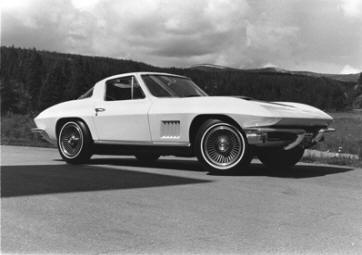 A
handful of Corvettes with the “L88”-code 427 engine slipped out of
the factory in 1967, each rated at 430 horsepower (321 kW), but the
L88 would be more closely associated with the redesigned 1968 and
’69 models. The L88 breathed through a single four-barrel carburetor
rather than the L71’s three two-barrels. The triple-carburetor
induction system was still available, however, as the Corvette was
offered with both the L88 and L71 versions of the 427. A
handful of Corvettes with the “L88”-code 427 engine slipped out of
the factory in 1967, each rated at 430 horsepower (321 kW), but the
L88 would be more closely associated with the redesigned 1968 and
’69 models. The L88 breathed through a single four-barrel carburetor
rather than the L71’s three two-barrels. The triple-carburetor
induction system was still available, however, as the Corvette was
offered with both the L88 and L71 versions of the 427.
No less than six versions of the engine were offered in 1969, the
final year for the 427. They included the L88, the L71 and a very
rare ZL1 427 that was built with a lightweight aluminum cylinder
block. Only two regular-production Corvettes were built with the ZL1
engine, putting them on the short list of the most collectible
Corvettes in history.
The big-block increased
in size to 454 cubic inches in 1970, and the original big-block
engine family exited the Corvette lineup after the 1974 model year.
The 2008 Corvette Z06’s LS7 engine offers big-block displacement and
horsepower, but in a more efficient small-block architecture.
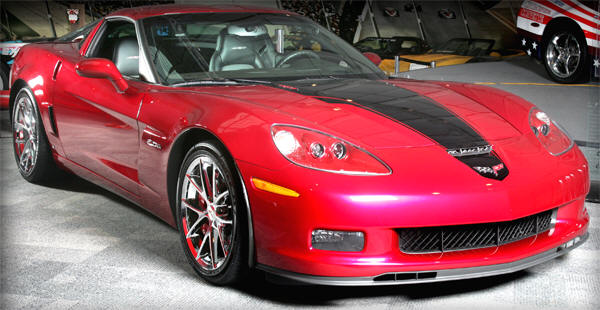
*SAE certified |

